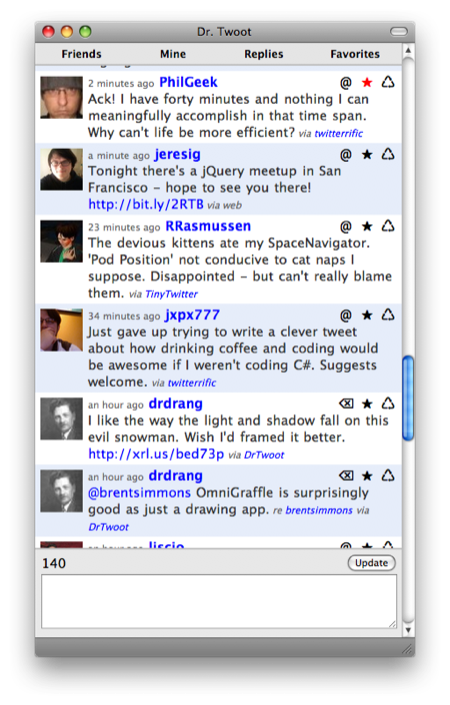Dr. Twoot
January 29, 2009 at 4:00 PM by Dr. Drang
OK, this is my last post on Twoot, the customizable Twitter web client originally written by Peter Krantz and so heavily altered by me that Peter probably wouldn’t recognize it anymore. I’ve decided to call my fork Dr. Twoot and give it its own self-named repository on GitHub. It’s reached a point in its development where I almost never need to pop over to twitter.com, so it’s feature-complete as far as I’m concerned.
This is what it looks like in its basic configuration

and here’s the list of features:
- It updates automatically every three minutes.
- From the toolbar at the top, you can:
- view your friends’ timeline;
- view your own timeline;
- view replies to you; and
- view your favorite tweets.
- Each tweet has buttons that let you:
- reply, if the tweet is from someone else (@);
- delete, if the tweet is from you (⌫);
- add it to your favorites list (★ changes to red);
- delete it from your favorites list (★ changes back to black); and
- retweet it (♺).
- Less obviously, each tweet has links to:
- the full-sized user picture (click the thumbnail);
- the tweet itself on twitter.com (click the timestamp);
- the user’s timeline (click the user name);
- the Twitter client used to write the tweet (click the name of the client); and
- the tweet it’s replying to or retweeting, when appropriate (click the user name after “re”).
- The message area at the bottom has a character countdown that:
- turns red when your within 20 of the 140-character limit; and
- changes to “Twoosh!” when you’re tweet hits exactly 140 characters.
- Links at the bottom of the list of tweets (not visible in the screenshot) let you page backward and forward through the tweet history.
Dr. Twoot is a set of HTML, CSS, and JavaScript files turned into a site-specific browser (SSB) using Fluid. Unlike most SSBs, Dr. Twoot sits on your own hard drive, so the only server availability you have to worry about is Twitter’s. If you want to try it out, download it from the repository and build it using these instructions. If you make your own improvements, I’d like to hear about them.

